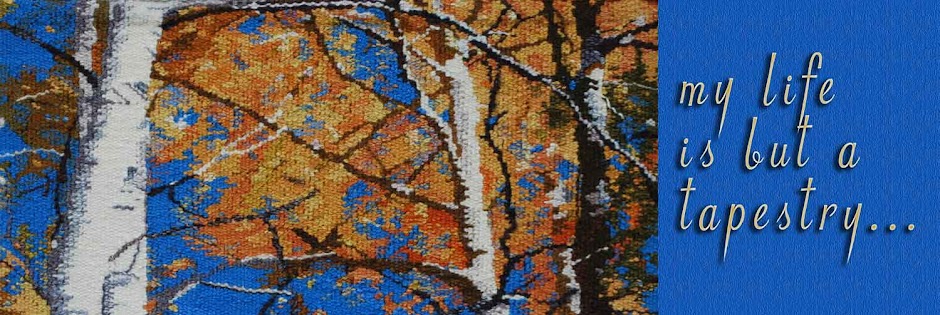
This shot tells you a lot about what I'm doing now, and will be doing until these tapestries are done. I will do it over and over and over and over and over....
I do not weave all the way across the tapestry. I 'shape weave,' which means I weave areas and shapes and build them up. For instance, to begin weaving the shapes that will define the anchor in the photo above, I first had to weave and build up everything underneath the anchor shapes, then I'll weave the anchor and the areas surrounding it, then will weave the area 'on top' of the anchor.
The borders of these tapestries are intentionally fairly simple. They have symbolic images on a blue background. But if you look at the blue area closely, you'll see that I never weave a solid color. I use two yarns together, and I have 6-7 blues that I will be using to create the blue, with occasional shots of blue/green or purple thrown in here and there. I vary the blue every time I run out of yarn, and more often even than that. It varies about every 2 inches across the 20 inches of tapestry.

The varied little bundles of yarn hanging in front of the weaving in the top photo are called 'butterflies.' (Ah,
here's where the butterflies don't fly!) I only use bobbins of yarn in the hem area, and if I have a large expanse of a single color, which, as I said, I rarely have. So, instead of bobbins I use butterflies, which are two strands of yarn, which I wind together in a figure-8 around my fingers and tie off to feed the yarn from one end for weaving. It takes a lot of butterfly winding to get good at it, and some weavers prefer to not use butterflies. But I prefer having the little hanks of yarn hanging in front of the weaving to keeping track of 30-40 bobbins, which seem to tangle for me. And I usually do have that many butterflies weaving at one time. Even in the 'solid blue' background area I wove before getting to the anchor, I had about 10 butterflies going across the 20 inches, so the blues would vary.

This is a shot of the two tapestries on my loom. It is an upright
Shannock loom, 6-feet wide, and made in the USA! I love my loom. It is an excellent tool, and has become a reliable friend in the studio.
As you can see, I have woven more on the tapestry on the right, so far than I have on the one to the left. I will try to keep them about even, weaving on one for a bit, then on the other to catch up. Perhaps you are thinking it looks like I've not done much yet! And I was just patting myself on the back for getting
so much done already! On a large complex tapestry, I weave about at the speed of 1-2 linear inches (all the way across, in other words) in an eight-hour weaving day. These two tapestries together make a large, complex tapestry. The borders are less complex, so are going a bit 'faster.' (
Fast is not usually a tapestry term.)

In addition to the studio work, yesterday was my day to paint with
Alzheimers patients. I was pleased to see that a few of the painters smaller pieces have been used this month to decorate the calendar in the hallway. I love the fish at the top! Today I had about 8 painters in all, with two of the men each doing 2 small paintings. These two men are a couple of my 'regulars' whom I've been painting with for several years. They both do remarkable little watercolors. The fish was done by one of them.



















































